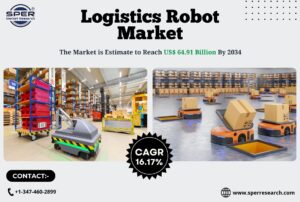Logistics Robot Market Growth and Investment 2034

A logistics robot is an automated system designed to enhance efficiency in warehouses, distribution centers, and supply chains. It handles tasks such as transporting goods, picking and packing items, sorting products, and managing inventory with minimal human involvement. Utilizing technologies like artificial intelligence, machine learning, computer vision, and sensors such as LiDAR, these robots can navigate complex environments, avoid obstacles, and manage items of varying sizes and weights accurately. By reducing manual labor, improving accuracy, and speeding up operations, logistics robots help businesses cut costs, save time, and meet the growing demands of e-commerce and fast delivery.
According to SPER market research, ‘Global Logistics Robot Market Size- By Component, By Application, By Industry – Regional Outlook, Competitive Strategies and Segment Forecast to 2034’ state that the Global Logistics Robot Market is predicted to reach 64.91 Billion by 2034 with a CAGR 16.17%.
Drivers:
The logistics robotics market is expanding rapidly, fueled by growing demand for automation, technological innovations, and efficiency in warehouses, distribution centers, and fulfillment centers. The surge in e-commerce and omnichannel retailing has increased the need for faster, accurate, and cost-effective operations. Companies are adopting AMRs, AGVs, and robotic picking systems to minimize manual labor, enhance order accuracy, and optimize space utilization. Advances in AI, machine learning, computer vision, and sensor technologies improve robot intelligence and autonomy. Labor shortages, rising wages, and the physical demands of warehouse work further drive adoption, enabling 24/7 operations, reducing errors, and lowering operational costs.
Download the Detailed Analysis in PDF format, Here
Restraints:
The logistics robot market faces multiple challenges despite its growth. High upfront costs and complex integration can deter small and medium-sized businesses. Deploying and maintaining AI-driven robots requires skilled personnel, adding operational complexity. Ensuring compatibility with existing warehouse systems can be difficult, while concerns over cybersecurity, data privacy, and system reliability impact adoption. Regulatory requirements and evolving safety standards also influence market expansion. Additionally, resistance to change and workforce adaptation pose hurdles, making widespread implementation of logistics robots a gradual and carefully managed process.
Asia Pacific dominates the logistics robotics market, fueled by fast industrialization, widespread automation adoption, and significant investments in smart manufacturing and logistics infrastructure. Nations like China, Japan, and India are increasingly implementing advanced robotics in warehouses, distribution centers, and transportation hubs to enhance efficiency and minimize reliance on manual labor. Some significant market players are Swisslog Holding AG, Honeywell International Inc, KNAPP AG, BEUMER Group, SSI Schaefer, Kawasaki Heavy Industries Ltd., Locus Robotics, Kion Group AG
For More Information, refer to below link: –
Related Reports:
Axial Piston Hydraulic Motor Market Size
Automotive Suspension Spring Market Size
Follow Us –
LinkedIn | Instagram | Facebook | Twitter
Contact Us:
Sara Lopes, Business Consultant — USA
SPER Market Research
enquiries@sperresearch.com
+1–347–460–2899





